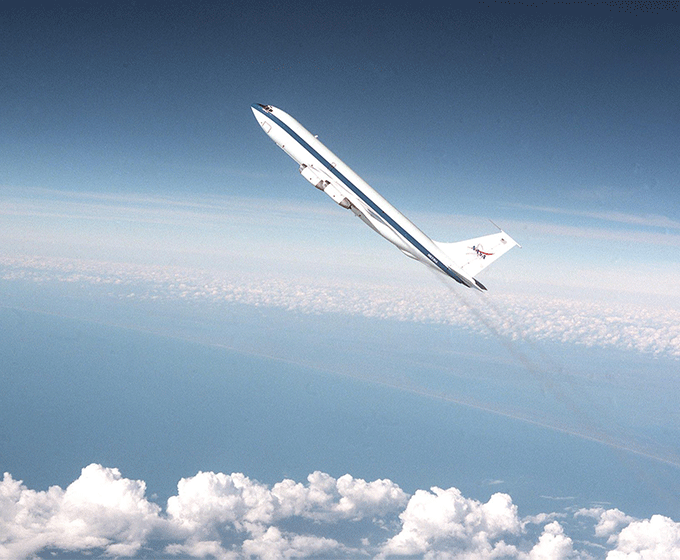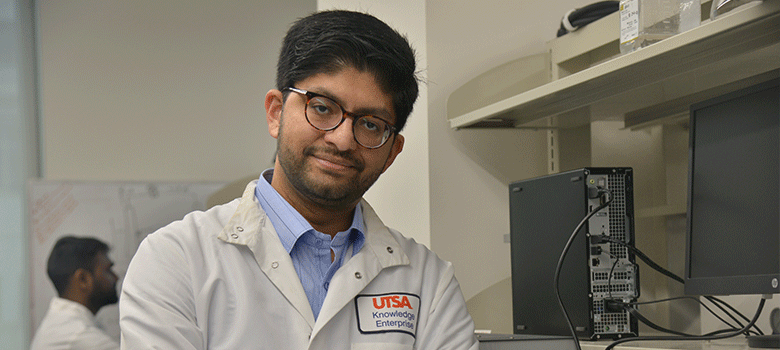
This image from the NASA Image and Video Library shows a specially modified KC-135A turbojet in a parabolic flight that produces weightless periods. Researchers from UTSA and SwRI will test novel electrolyzer technology in parabolic flights like these to study its boiling processes under partial gravity.
JULY 11, 2025 — Southwest Research Institute (SwRI) and The University of Texas at San Antonio (UTSA) will receive a $500,000 award from NASA’s TechLeap Prize program to flight test novel electrolyzer technology designed to improve the production of propellants and life-support compounds on the moon, Mars or near-Earth asteroids.
The project, known as the Mars Atmospheric Reactor for Synthesis of Consumables (MARS-C), is led by SwRI’s Kevin Supak and Eugene Hoffman, and by Shrihari “Shri” Sankarasubramanian, assistant professor in the Department of Biomedical and Chemical Engineering at UTSA.
TechLeap prizes support future missions by advancing transformative solutions that address NASA’s technology shortfalls. The SwRI/UTSA group is one of nine prizewinners funded to test their payloads on suborbital, hosted orbital or parabolic flights. The program aims to accelerate technology testing timelines, allowing completion within one year of the award.
SwRI and UTSA researchers will evaluate the performance of a patent-pending electrolyzer developed with NASA support by Sankarasubramanian and his team. The device applies a voltage across two electrodes to drive the electrochemical conversion of a simulated Martian brine and carbon dioxide into methane and other hydrocarbons. This technology is designed to use local resources on the moon or Mars to produce fuel, oxygen and other life support compounds needed for long-term human habitation.

Shrihari “Shri” Sankarasubramanian, assistant professor in the UTSA Department of Biomedical and Chemical Engineering, is part of a San Antonio research team that will test electrolyzer technology on parabolic flights.
The work builds on previous research conducted by SwRI, which involved studying boiling processes under partial gravity aboard parabolic flights. Designed to understand how liquids might behave on lunar or Martian surfaces, the research demonstrated that partial gravity affects surface bubble dynamics, which can affect gas production rates.
“In a partial gravity environment, like the moon or Mars, a reduced buoyancy effect on gas bubbles in an electrolyzer poses challenges that aren’t present on Earth,” Supak said. “We lack an understanding about chemical processes that leverage bubble nucleation in low gravity, which is the gap we aim to fill.”
To address this, SwRI and UTSA will integrate the technology into an existing SwRI-built flight rig and test it aboard a parabolic flight, capitalizing on the Institute’s successful history testing technology in reduced gravity aircraft and suborbital spacecraft.
“We plan to acquire bubble nucleation and fluid motion videos in an operating electrolyzer during the parabolic flight,” Sankarasubramanian said. “Understanding these processes can help us improve the overall efficiency and performance of these electrolyzers.”
After the flight rig is complete, SwRI will conduct ground tests before the parabolic flight to establish operating procedures and ensure a successful demonstration. The flight is planned for 2026.
“Humans have an intrinsic drive to push the boundaries of what’s possible,” Supak said. “Exploring space catalyzes technological advancements that have far-reaching benefits in our daily lives — often unanticipated innovations arise as a direct result of overcoming the unique challenges of space exploration. Establishing permanent presences on other planetary bodies could pave the way for unprecedented scientific discoveries and technological breakthroughs.”
UTSA Today is produced by University Communications and Marketing, the official news source of The University of Texas at San Antonio. Send your feedback to news@utsa.edu. Keep up-to-date on UTSA news by visiting UTSA Today. Connect with UTSA online at Facebook, Twitter, Youtube and Instagram.
Move In To COLFA is strongly recommended for new students in COLFA. It gives you the chance to learn about the Student Success Center, campus resources and meet new friends!
Academic Classroom: Lecture Hall (MH 2.01.10,) McKinney Humanities BldgWe invite you to join us for Birds Up! Downtown, an exciting welcome back event designed to connect students with the different departments at the Downtown Campus. Students will have the opportunity to learn about some of the departments on campus, gain access to different resources, and collect some giveaways!
Bill Miller PlazaCome and celebrate this year's homecoming at the Downtown Campus with food, games, giveaways, music, and more. We look forward to seeing your Roadrunner Spirit!
Bill Miller PlazaThe University of Texas at San Antonio is dedicated to the advancement of knowledge through research and discovery, teaching and learning, community engagement and public service. As an institution of access and excellence, UTSA embraces multicultural traditions and serves as a center for intellectual and creative resources as well as a catalyst for socioeconomic development and the commercialization of intellectual property - for Texas, the nation and the world.
To be a premier public research university, providing access to educational excellence and preparing citizen leaders for the global environment.
We encourage an environment of dialogue and discovery, where integrity, excellence, respect, collaboration and innovation are fostered.